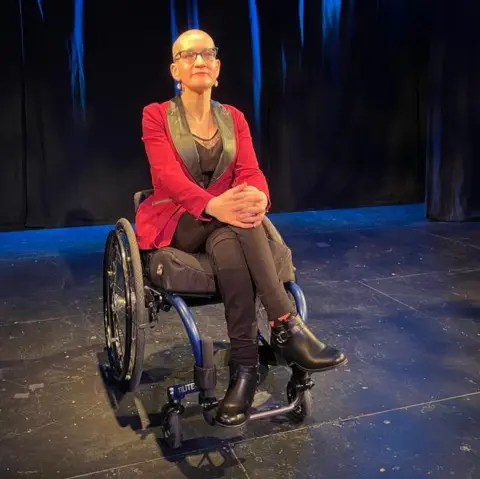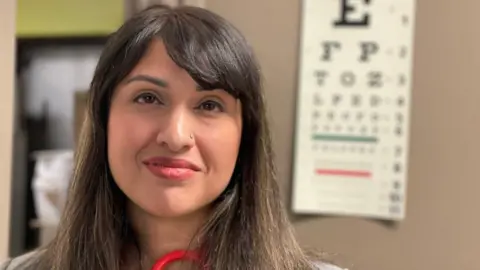Editor
Global health producer
 Bbc
BbcApril Hubbard is sitting on the stage of the theater where she plans to die later this year.
It is not in terminal phase, but the performance and the 39 -year -old burlesque artist was approved to die under the increasingly liberal laws of Canada.
Warning: This article contains details and descriptions that some readers may find disturbing
It is addressed to BBC News from the Stop Theater bus, an intimate auditorium with just under 100 seats, in the eastern city of Halifax, in Nova Scotia.
Illuminated by a single projector on a scene on which she played several times before, she tells me that she plans to die here “in a few months” of her imminent 40th anniversary. She will be joined by a small group of her family and friends.
April plans to be in a “comfortable big bed” for what it calls a “festive” moment when a health professional will inject a fatal dose into his blood circulation.
“I want to be surrounded by the people I love and that everyone holds me in a puddle of giant hugs and can take my last breath, surrounded by love and support,” she said.
April was born with Spina Bifida and was then diagnosed with tumors at the base of her spine which, according to her, left her in constant and debilitating pain.
She has been taking opioid pain relievers for over 20 years and asked for medical assistance in Dying (Maid) in March 2023. Although she could still live for decades with her condition, she qualified to end her life at the beginning of the seven months after the possibility of applying. For those who are in terminal phase, it is possible to obtain approval within 24 hours.
“My suffering and pain increase and I no longer have the quality of life that makes me happy and fulfilled,” said April. Whenever she moves or breathes, she says that the fabrics of the base of her spine “are drawn like an elastic which extends too far”, and that its lower limbs leave it to agony.
We meet in April because, nearly 3,000 miles from there, the deputies examine the proposals to legalize the assisted death in England and the land of Wales. They voted in principle to support these plans in November 2024, but months of detailed control followed – and other votes in the common goods and the lords are required before the bill could become law.
This week, the BBC attended the death of a man in CaliforniaWhere the laws on assisted mussels are much more similar to those considered to be Westminster.
Critics say that Canada is an example of the “slippery slope”, which means that once you adopt an assisted dying law, it will inevitably expand its scope and will have fewer guarantees.
Canada now has one of the most liberal systems to die around the world, similar to that operating in the Netherlands and Belgium. He introduced Maid in 2016, initially for terminal adults with a serious and incurable physical disease, which causes intolerable suffering. In 2021, the need to be in terminal phase was removed and, in two years, the Canadian government plans to open a maid to adults only with mental illness and no physical illness.
Opponents of the maid tell us that death is considered a standard treatment option for disabled people and complex medical problems.
“It is easier in Canada to obtain medical assistance by dying than to support the government,” said Andrew Gurza, consultant in disability awareness and friend of April.
Andrew, who suffers from cerebral paralysis and uses a wheelchair, says that he respects April’s decision, but tells us: “If my handicap decreases and my care needs have become higher, I would always like to be here. To know that there is a law that says that you could easily put an end to your life – it’s really scary.”

Before it was approved for Maid, April was evaluated by two independent doctors who had to inform its means of relieving its suffering and offering other treatments.
“The guarantees are there,” she says, when we press the disabled people who feel threatened by assisted death, or if the maid is used as a shortcut for better quality care. “If this does not suit you and you do not direct the charge and do not choose a maid, you will not be able to access it unless it is for the right reasons,” she adds.
There have been 15,343 deaths of maid in 2023, representing approximately one in 20 of all deaths in Canada – a proportion that has increased considerably since 2016 and is one of the highest in the world. The average age of the beneficiaries was 77.
In all except a handful of cases, the fatal dose was delivered by a doctor or a nurse, also known as the voluntary euthanasia. A doctor to whom we talked, Eric Thomas, said that he had helped 577 patients to die.
Dr. Konia Trouton, president of the Canadian Association of Evaluators and Suppliers, has also helped hundreds of patients to die since the introduction of the law.
The procedure is the same each time – she arrives at the home of the person who received the approval from Maid and asks him if she wishes to go ahead that day. She says patients always direct the process and then give it the “head high and ready to leave”.
“It gives me an honor and a duty and a privilege to be able to help them in these last moments with their family around them, with those who love them around them and to know that they have made this decision in a thoughtful, carefully and carefully,” she adds. If the answer is yes, she opens her medical bag.
Demonstrating to the BBC what is happening next, Dr. TRISTON briefly puts a tourniquet on my arm. It shows me where the needle would be inserted into a vein at the back of my hand to allow an intravenous infusion of fatal medications.
In her medical bag, she also has a stethoscope. “Strangely, these days, I use it more to determine if someone has no heartbeat rather than if they do it,” she said.
A list of organizations in the United Kingdom offering support and information with some of the problems in this story is available to BBC Action Line
Some 96% of maid’s measures are under “track one” where death is “reasonably predictable”. Dr. TRISTON says it means that patients are on a “trajectory towards death”, which could go from someone who has quickly spread cancer and only weeks to live or another with “who could be five to seven” Alzheimer’s “.
The other 4% of the deaths of servants are “track Two”. These are adults, like April, who do not die but who have suffering which are intolerable to them from a “serious and irremediable medical condition”.
This contrasts strongly with the bill of Labor MP for Kim Leadbeater to legalize assisted death in England and Wales, which says that patients must die in the six months. Westminster’s bill would not allow doctors to give a fatal dose – patients should rather self -administer drugs, generally by swallowing them.
Death via an intravenous infusion normally only takes a few minutes, as fatal medications enter the blood circulation directly, while swallowing drugs means that patients usually take about an hour or two to die, but can take much more time, although they are generally unconscious after a few minutes.
Dr. Trouton told me that she considered the Canadian system to be faster and more efficient, just like other chambermaid suppliers. “I fear that if some people cannot swallow because of their pathological process, and if they are unable to take the amount of drugs due to breathing difficulties or difficulties to swallow, what will happen?”
“Canada fell from a cliff”
But opponents argue that it is used as a cheaper alternative to the provision of adequate social or medical support.
One of them is Dr. Ramona Coelho, a general practitioner in London, Ontario, whose practice serves many marginalized groups and those who find it difficult to obtain medical and social support. She is part of an examination committee for the death of a maid, alongside Dr. Trouton, who examines cases in the province.
Dr Coelho told me that Maid was “out of control”. “I wouldn’t even call it a slippery slope,” she said, “Canada fell from a cliff.”

“When people have suicidal ideas, we used to meet them advice and care, and for people with terminal phase and other diseases, we could alleviate this suffering and help them have a better life,” she said. “However, we see this as an appropriate request to die and end their lives very quickly.”
While during Dr Coelho surgery, I was presented to Vicki Whelan, a retired nurse whose mother Sharon Scribner died in April 2023 from lung cancer, 811. Vicki told me that in her mother in the last days in the hospital, she has repeatedly offered the possibility of maid by medical staff, describing her as a “sales pitch”.
The Catholic family released her mother so that she could die at home, where Vicki says that her mother had a “magnificent and peaceful death”. “It makes us think that we cannot bear, and we cannot suffer a little, and that now they have decided that death should be helped, where we have been dying for years.
“All of a sudden, we tell people that it is a better option. It is an easy outcome and I think it’s just to steal people of hope.”
‘Not a way I want to live’
Is Canada an example of the so-called slippery slope? It is certainly true that the eligibility criteria have been considerably widened since the introduction of the law nine years ago, so for criticism, the answer would be a categorical yes and would serve as a warning to Great Britain.
Canada’s dying laws have been led by court decisions. His supreme court asked the Parliament that a ban on dying violated the country’s rights and freedoms. The extension of eligibility to those who were not in terminal phase was partly a response to another court decision.
In Great Britain, the judges of the highest courts of people said on several occasions that any potential change in the law around assisted death is a question for Parliament, after Tony Nicklinson, Diane Pretty and Noel Conway, argued that the general ban on suicide helped his human rights.
April knows that some people can look at her, a young woman, and wonder why she would die.
“We are the masking masters and do not let people see that we suffer,” she said. “But in reality, there are days when I cannot hide it, and there are several days when I cannot raise my head of the pillow and I can no longer eat.
“It is not a way of still living 10 or 20 or 30 years.”
Additional report by Joshua Falcon.



